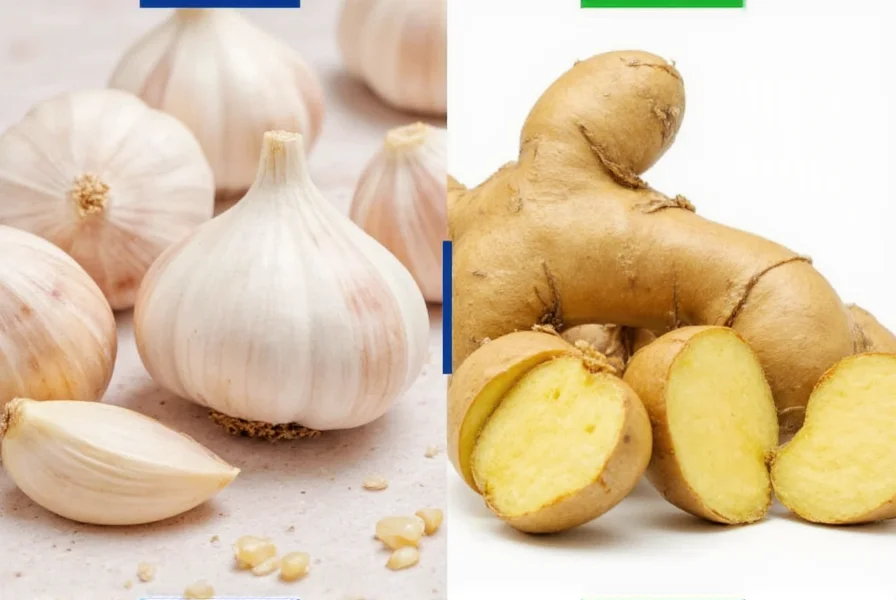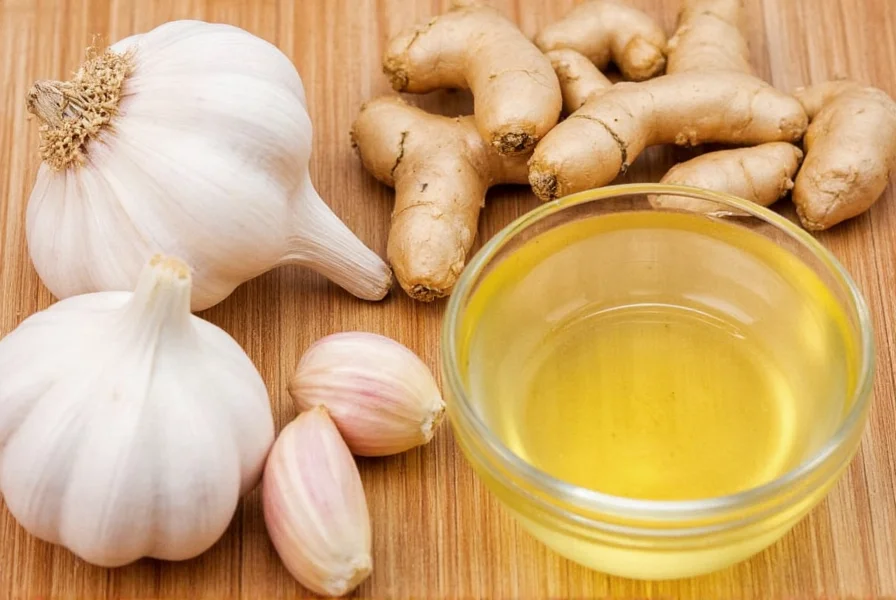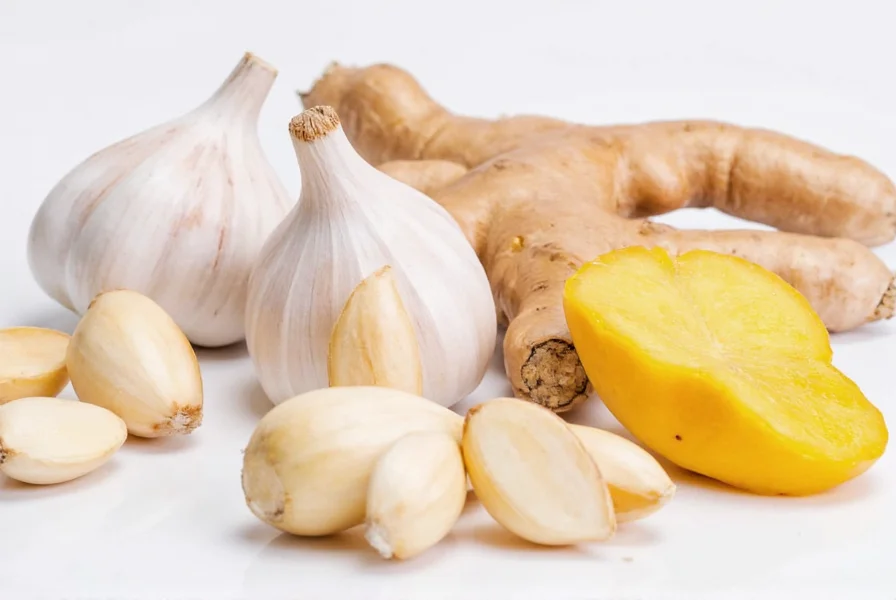These ancient remedies have stood the test of time for good reason. Modern research continues to validate traditional uses while revealing new potential applications for these versatile ingredients. Understanding their specific benefits, optimal usage, and how they complement each other can help you make informed decisions about incorporating them into your wellness routine.
Nutritional Comparison of Garlic and Ginger
| Nutrient | Garlic (1 oz/28g) | Ginger (1 oz/28g) |
|---|---|---|
| Calories | 26 | 20 |
| Carbohydrates | 6g | 4g |
| Fiber | 0.6g | 0.6g |
| Vitamin C | 2% DV | 4% DV |
| Vitamin B6 | 8% DV | 2% DV |
| Manganese | 1% DV | 14% DV |
| Key Bioactives | Allicin, diallyl disulfide | Gingerol, shogaol |
Science-Backed Health Benefits of Garlic
Garlic's primary bioactive compound, allicin, forms when raw garlic is crushed or chopped. This sulfur-containing compound delivers multiple health advantages supported by clinical research. Studies published in the Journal of Nutrition demonstrate that regular garlic consumption may help maintain healthy blood pressure levels in adults with mild hypertension. The mechanism appears related to garlic's ability to stimulate nitric oxide production, which helps blood vessels relax.
Research on garlic and cardiovascular health shows promising results for cholesterol management. A meta-analysis in Nutrition Reviews found that garlic supplementation significantly reduced total and LDL cholesterol levels in participants with elevated values. The antiplatelet properties of garlic compounds may also contribute to improved blood flow, though individuals taking blood thinners should consult their healthcare provider before significantly increasing garlic intake.
When considering garlic for immune system support, multiple studies indicate regular consumption may reduce the frequency and severity of common colds. The antimicrobial properties of allicin work against various bacteria, viruses, and fungi, making garlic a valuable addition to your dietary defense strategy.

Proven Health Benefits of Ginger
Ginger's therapeutic properties primarily come from gingerol, a bioactive compound with potent anti-inflammatory and antioxidant effects. Clinical trials consistently demonstrate ginger's effectiveness for managing nausea and digestive discomfort. Research in the American Journal of Obstetrics and Gynecology found that 1 gram of ginger daily significantly reduced pregnancy-related nausea without adverse effects.
For individuals seeking natural approaches to pain management with ginger, studies show promising results. Research published in Arthritis & Rheumatism reported that ginger extract reduced osteoarthritis pain and stiffness in study participants. The anti-inflammatory mechanism appears similar to non-steroidal anti-inflammatory drugs (NSAIDs), but with fewer gastrointestinal side effects.
Ginger's metabolic benefits extend to blood sugar regulation. A study in Complementary Therapies in Medicine showed that 2 grams of ginger powder daily reduced fasting blood sugar and improved insulin sensitivity in people with type 2 diabetes. These findings suggest ginger may be a valuable dietary component for metabolic health support.
Synergistic Effects of Combining Garlic and Ginger
When used together, garlic and ginger create a powerful combination that enhances their individual benefits. The complementary anti-inflammatory pathways activated by allicin and gingerol work through different mechanisms, providing broader protection against chronic inflammation. This garlic and ginger synergy for inflammation reduction makes them particularly valuable for long-term wellness strategies.
Traditional medicine systems like Ayurveda and Traditional Chinese Medicine have long combined these ingredients for immune support. Modern research supports this practice, with studies showing that the combined antioxidant capacity exceeds what either provides alone. The dual approach targets multiple free radical types while supporting the body's natural antioxidant enzyme systems.
For those interested in garlic and ginger for respiratory health, the combination shows particular promise. Both ingredients support healthy mucus clearance while providing antimicrobial protection. A study in Food and Chemical Toxicology demonstrated that this combination enhanced immune cell activity against respiratory pathogens more effectively than either ingredient alone.
Optimal Culinary Applications and Preparation Methods
To maximize the health benefits of garlic, allow crushed or chopped garlic to sit for 10 minutes before cooking. This waiting period enables the alliinase enzyme to fully convert alliin to allicin, the compound responsible for most of garlic's health benefits. Adding garlic late in the cooking process preserves more of these valuable compounds.
For ginger, fresh is generally best for maximizing gingerol content. Grating or mincing releases more bioactive compounds than slicing. When using in teas or soups, add ginger early in cooking to extract maximum benefits, as the heat converts gingerol to shogaol, which has different but equally valuable properties.
Consider these effective combinations:
- Immune-boosting broth: Simmer garlic, ginger, turmeric, and lemon in vegetable broth
- Digestive tea: Steep fresh ginger and a small clove of crushed garlic in hot water
- Anti-inflammatory dressing: Blend garlic, ginger, olive oil, lemon juice, and a touch of honey

Scientific Evidence Overview
A comprehensive review in Antioxidants analyzed over 50 clinical studies on garlic and ginger. The review concluded that both demonstrate significant antioxidant activity, with particular strength in reducing markers of oxidative stress like malondialdehyde (MDA). The combined effect showed additive benefits in 78% of studies examining their interaction.
Research on garlic and ginger for cardiovascular health reveals complementary mechanisms. While garlic primarily supports vascular function through nitric oxide pathways, ginger improves blood lipid profiles and reduces platelet aggregation through different biochemical routes. This dual-action approach may provide more comprehensive cardiovascular support than either alone.
When examining the evidence for garlic ginger anti-inflammatory effects, multiple studies show they inhibit different inflammatory pathways. Garlic suppresses NF-kB activation while ginger targets COX-2 and 5-LOX enzymes. This multi-target approach may explain why traditional medicine systems have valued their combination for centuries.
Practical Usage Guidelines
For general wellness, aim for 1-2 cloves of raw or cooked garlic daily along with 1-2 grams of fresh ginger (about a 1-inch piece). To maximize absorption, consume these ingredients with healthy fats like olive oil or avocado, as many of their bioactive compounds are fat-soluble.
Timing matters for specific benefits. Consuming ginger 30 minutes before meals may enhance digestive benefits, while garlic appears most effective for cardiovascular support when consumed regularly throughout the day. For immune support during cold and flu season, consider increasing intake slightly while monitoring for any digestive discomfort.
When preparing garlic and ginger tea for colds, use freshly grated ingredients and allow them to steep for at least 10 minutes. Adding lemon juice can enhance the extraction of certain compounds while providing additional vitamin C to support immune function.
Potential Considerations and Side Effects
While generally safe for most people, some individuals may experience digestive discomfort when consuming garlic and ginger, particularly in larger quantities. Start with smaller amounts and gradually increase to assess tolerance. Raw garlic may cause heartburn in sensitive individuals, while ginger can produce a warming sensation that some find uncomfortable.
Those taking blood-thinning medications should consult their healthcare provider before significantly increasing garlic intake, as it may enhance the medication's effects. Similarly, individuals with gallstone issues should monitor their response to ginger, as it stimulates bile production.
Pregnant women can generally consume moderate amounts of both ingredients as part of their diet, but should avoid high-dose supplements without medical supervision. The American College of Obstetricians and Gynecologists considers culinary amounts of ginger safe during pregnancy for nausea management.
Frequently Asked Questions
What's the best way to prepare garlic and ginger to maximize health benefits?
For garlic, crush or chop and let sit for 10 minutes before cooking to activate allicin formation. Add to dishes near the end of cooking to preserve compounds. For ginger, grate fresh root to release maximum gingerol, and add early in cooking for digestive benefits or later for stronger anti-inflammatory effects. Combining both with healthy fats like olive oil enhances absorption of their bioactive compounds.
Can garlic and ginger help with weight management?
Research suggests both ingredients may support metabolic health. Ginger has been shown to increase thermogenesis and improve insulin sensitivity, while garlic compounds may help regulate fat metabolism. A study in Metabolism found that ginger supplementation reduced waist-to-hip ratio andscrição body mass index. However, they work best as part of a balanced diet and active lifestyle rather than standalone weight loss solutions.
How much garlic and ginger should I consume daily for health benefits?
For general wellness, 1-2 cloves of garlic (about 4-8 grams) and 1-2 grams of fresh ginger (approximately a 1-inch piece) daily provides evidence-based benefits without significant side effects for most adults. Those using them for specific therapeutic purposes may benefit from higher amounts under professional guidance, but should monitor for digestive tolerance.
Are there any medication interactions to be aware of with garlic and ginger?
Garlic may enhance the effects of blood-thinning medications like warfarin, increasing bleeding risk. Ginger in large amounts may have similar effects. Both may interact with diabetes medications by potentially enhancing blood sugar-lowering effects. If you take medications for blood pressure, blood sugar, or blood clotting, consult your healthcare provider before significantly increasing garlic or ginger intake.
Can I take garlic and ginger supplements instead of fresh ingredients?
Supplements can provide concentrated doses of specific compounds, but they lack the full spectrum of beneficial compounds found in whole foods. Fresh garlic and ginger contain multiple synergistic compounds that work together. If choosing supplements, look for standardized extracts with clear labeling of active compound concentrations, and consult a healthcare provider to ensure appropriate dosing for your needs.











 浙公网安备
33010002000092号
浙公网安备
33010002000092号 浙B2-20120091-4
浙B2-20120091-4